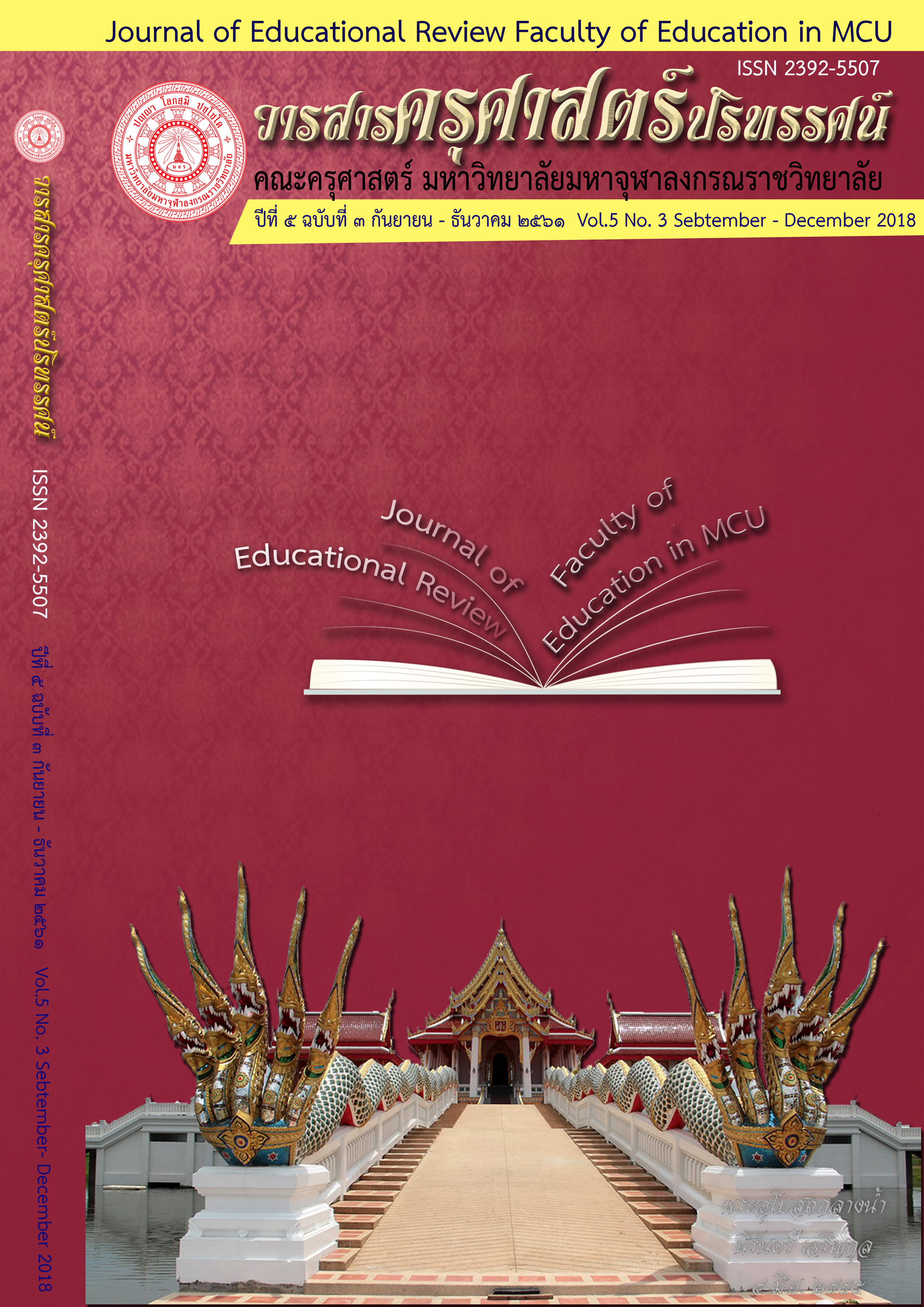A Model of Learning Center Development in Buddhist Oriented School
Main Article Content
Abstract
The research objectives were to study problems of learning centers in Buddhist
oriented schools, to develop a development model of learning centers in Buddhist
oriented schools, and to propose a development model of learning centers in
Buddhist oriented schools. The mixed research methods were used in the study. The
data were collected by questionnaires from 394 subjects in Buddhist oriented
schools, Training Plan and Development Section in Vipassana Meditation Institute of
Mahachulalongkornrajavidyalaya University, and Bureau of Innovative Education
Management of Office of the Basic Education Commission. The data were analyzed
by frequency, percentage, average, and standard deviation.
The study results found that:
1. The current conditions of Buddhist oriented schools and learning centers of
Buddhist oriented schools; 1) The Buddhist oriented schools are operated by Training
Plan and Development Section in Vipassana Meditation Institute of
Mahachulalongkornrajavidyalaya University and Bureau of Innovative Education
Management of Office of the Basic Education Commission. There are 3 school levels;
general Buddhist oriented schools, leading Buddhist oriented schools, and Royal
awarded Buddhist oriented schools. The Buddhist oriented schools are managed
under 29 identities in 5 aspects; Physical characteristics, Teaching and Learning,
Behaviors of teachers and students, Buddhist oriented promotion, and Activity in
Buddhist Holiday. The learning centers in Buddhist oriented schools are still under
the study process. 2) Conditions of problems in Buddhist oriented schools can be
concluded into 8 aspects; 1) Administration, 2) Students, 3) Teachers, 4) School
administrators, 5) Student’s parents/guardians, 6) Buildings, 7) Activity management,
and 8) The Buddhist oriented school network.
2. The development model of learning centers in Buddhist oriented schools
consists of 3 main parts; the lead, the process, and the application. The details are as
follows: 1) the lead includes principle, objective, environment and indicators. 2) the
process consists of learning center components, operation, improvement, and
improvement activity, and 3) the application consists of preparation, implementation,
monitoring and evaluation.
3. The proposed development model of learning centers in Buddhist oriented
schools is appropriate at the high level overall. When considered in each topic, the
process and the building are the most suitable, followed by application and activity
process respectively.
Article Details
ทัศนะและความคิดเห็นที่ปรากฏในบทความในวารสารฉบับนี้ถือเป็นความรับผิดชอบของผู้เขียนบทความนั้นเพียงผู้เดียว และไม่ถือเป็นทัศนะและความรับผิดชอบของกองบรรณาธิการ
กองบรรณาธิการขอสงวนสิทธิ์ในการคัดเลือกบทความลงตีพิมพ์และจะแจ้งให้เจ้าของบทความทราบหลังจากผู้ประเมินบทความตรวจอ่านบทความแล้ว
ต้นฉบับที่ได้รับการตีพิมพ์ในวารสารครุศาสตร์ปริทรรศน์ คณะครุศาสตร์ มหาวิทยาลัยมหาจุฬาลงกรณราชวิทยาลัย ถือเป็นกรรมสิทธิ์ของคณะครุศาสตร์ มหาวิทยาลัยมหาจุฬาลงกรณราชวิทยาลัย ห้ามนำข้อความทั้งหมดหรือบางส่วนไปพิมพ์ซ้ำ เว้นเสียแต่ว่าจะได้รับอนุญาตจากมหาวิทยาลัยฯ เป็นลายลักษณ์อักษร
References
พิมพ์องค์การรับส่งสินค้าและพัศดุภัณฑ์ (ร.ส.พ.).
กลุ่มสาระสนเทศ, ส านักงานคณะกรรมการการศึกษาขั้นพื้นฐาน. (๑๖ กุมภาพันธ์ ๒๕๖๐). ข้อมูล
ส านักงานเขตพื้นที่การศึกษาทั่วประเทศ . แหล่งที่มา https://data.boppobec.info/emis/area_school.php.
กัมปนาท ศรีสุนทร. (๒๕๕๐). การพัฒนาการมีส่วนร่วมของชุมชนในการจัดการเรียนรู้ : ศึกษา
เฉพาะกรณีโรงเรียน ชุมชนบ้านโพธิ์สองห้องวิทยา อ าเภอวาปีปทุม จังหวัด
มหาสารคาม. วิทยานิพนธ์ศาสนศาสตรมหาบัณฑิต. บัณฑิตวิทยาลัย : มหาวิทยาลัยมหา
มกุฎราชวิทยาลัย.
จีรวัสส์ เรือนพันธ์. (๒๕๕๐). การใช้แหล่งการเรียนรู้ในชุมชนเพื่อจัดกิจกรรมการเรียนรู้วิชา
ชีววิทยาเรื่องความหลากหลายของสิ่งมีชีวิต. วิทยานิพนธ์ศึกษาศาสตรมหาบัณฑิต.
บัณฑิตวิทยาลัย : มหาวิทยาลัยเชียงใหม่.
ณัฐนันท์ ยอดธนันชัย. (๒๕๕๒). ศูนย์การเรียนรู้ชุมชน กับการแนะแนวการศึกษา อาชีพชีวิตและ
สังคม. วิทยานิพนธ์ศึกษาศาสตรมหาบัณฑิต. บัณฑิตวิทยาลัย :มหาวิทยาลัยเชียงใหม่.
ณัฐพล สียิ่งพิบูล. (๒๕๕๒). ศูนย์การเรียนชุมชมที่มีความยืดหยุ่นในการใช้งานพื้นที่ศูนย์บริการ
การศึกษานอกโรงเรียนเขตพระโขนง : แนวทางการออกแบบและบริหารจัดการ.
วิทยานิพนธ์สถาปัตยกรรมศาสตรมหาบัณฑิต. บัณฑิตวิทยาลัย : มหาวิทยาลัยธรรมศาสตร์.
ทศพิธ แป้นดวงเนตร. (๒๕๕๔). ศูนย์การเรียนรู้ชุมชนเพื่อส่งเสริมการท่องเที่ยวและพัฒนาอาชีพ
โดยชุมชนชาวจีนยูนนาน บ้านสันติชล ต าบลเวียงใต้ อ าเภอปาย จังหวัดแม่ฮ่องสอน.
วิทยานิพนธ์ศึกษาศาสตรมหาบัณฑิต. บัณฑิตวิทยาลัย : มหาวิทยาลัยเชียงใหม่.
พระฌอน ชยสาโร(ชยสาโรภิกขุ). (๒๕๔๙). โหลหนึ่งก็ถึง : คุณธรรม ๑๒ ประการ เพื่อความส าเร็จ
ในการศึกษาวิถีพุทธ. กรุงเทพมหานคร: โรงพิมพ์คิวพริ้นท์แมเนจเม้นท์.
พระพรหมคุณาภรณ (ป. อ. ปยุตฺโต). (๒๕๔๗). การศึกษาเริ่มตนเมื่อคน กิน อยู่ ดู ฟังเป็น.
กรุงเทพมหานคร: โรงพิมพ์อุษาการพิมพ.
รุ่งรัตน์ จิณะเสน. (๒๕๕๐). การพัฒนาระบบการให้บริการสื่อ ของศูนย์การเรียนรู้ด้วยตัวเอง คณะ
มนุษย์ศาสตร์ มหาวิทยาลัยเชียงใหม่. วิทยานิพนธ์ศึกษาศาสตรมหาบัณฑิต. บัณฑิต
วิทยาลัย :มหาวิทยาลัยเชียงใหม่.วิไล วิทย์ประเสริฐกุล. (๒๕๔๙). การศึกษาสภาพและปัญหาการบริหารโรงเรียนวิถีพุทธ สังกัด
ส านักงาน คณะกรรมการการศึกษาขั้นพื้นฐานในกรุงเทพมหานคร. วิทยานิพนธ์
ปริญญาครุศาสตรมหาบัณฑิต. คณะครุศาสตร์ : จุฬาลงกรณ์มหาวิทยาลัย.
สมเด็จพระพุฒาจารย์ (เกี่ยว อุปเสณมหาเถระ). (๒๕๔๗). ค ากล่าวสัมโมทนียกถา ยุทธศาสตร์การ
พัฒนาโรงเรียนวิถีพุทธ. กรุงเทพมหานคร: โรงพิมพ์อุษาการพิมพ์.
ส่วนวางแผนและพัฒนาการอบรม มหาวิทยาลัยมหาจุฬาลงกรณราชวิทยาลัย. (๑๖ กุมภาพันธ์
๒๕๖๐). สถิติโรงเรียนวิถีพุทธ. แหล่งที่มา: http://www.vitheebuddha.com.
ส านักพัฒนานวัตกรรมการจัดการศึกษา. (๑๖ กุมภาพันธ์ ๒๕๖๐). แนวทางด าเนินการ ๒๙ ประการ
สู่ความเป็นโรงเรียนวิถีพุทธ. แหล่งที่มา: http://www.vitheebuddha.com.
สุรชาติ อินแผลง. (๒๕๕๐). การศึกษาสภาพการด าเนินงานโรงเรียนวิถีพุทธ สังกัดส านักงานเขต
พื้นที่ การศึกษาเลย เขต ๑ : กรณีศึกษาโรงเรียนบานติ้วนอย. วิทยานิพนธ์ปริญญา
ศึกษาศาสตรมหาบัณฑิต. บัณฑิตวิทยาลัย : มหาวิทยาลัยขอนแกน.
อชิรญาณ์ ยันตพร. (๒๕๕๒). การพัฒนาศูนย์การเรียนรู้ ชุมชนบางขุนไทร ด าบลบางขุนไทร
อ าเภอบ้านแหลม จังหวัด เพชรบุรี. วิทยานิพนธ์ศิลปศาสตรมหาบัณฑิต. บัณฑิต
วิทยาลัย : มหาวิทยาลัยศิลปากร.


